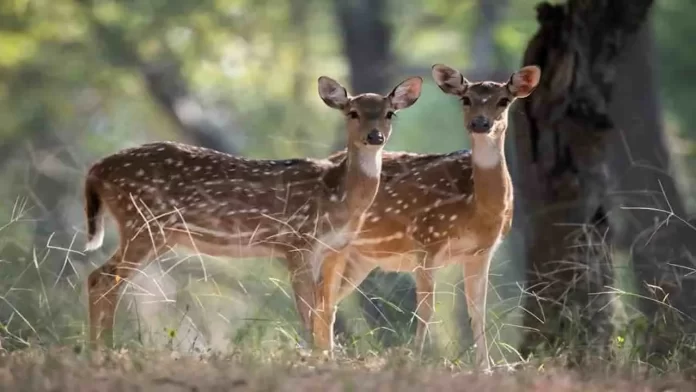A plea in the Delhi High Court has led to “status quo” on the translocation of deer from Deer Park to Rajasthan. Translocation has to be done with care as it could led to the species’ extinction
Recently, the Delhi High Court ordered “status quo” on the translocation of spotted deer from Deer Park to forest areas in the city as well as Rajasthan after its recognition as a “mini zoo” was cancelled in June. A bench, comprising Acting Chief Justice Manmohan and Justice Mini Pushkarna was hearing a plea of the New Delhi Nature Society challenging the decision of the Central Zoo Authority and seeking a stay on it. The bench urged the authorities to address the petitioner’s plea and recommended that at least 50 deer be kept in Deer Park so that children can view them, while the others may be relocated to the Ridge or DDA-controlled open spaces. The bench emphasised that deer won’t survive in the Rajasthan jungle because there were too many leopards there.
Officials said that the decision to cancel Deer Park’s license as a zoo was taken in view of the rapid growth of deer population, inbreeding, possibility of spread of disease and lack of trained manpower to maintain it. The decision was taken at a meeting held under the chairmanship of Sanjay Kumar Shukla, Member Secretary, Central Zoo Authority, on January 30 to deliberate shifting of deer and cancellation of recognition to AN Jha Deer Park, Hauz Khas, New Delhi.
The decision made it clear that the area’s land use will remain as a Green Protected Forest, according to the environment ministry. The ministry in its order said that the recognition of Deer Park was valid till August 19, 2021, and decided to not extend it. However, the committee also underlined the fact that the zoo site is an important urban green space and must be preserved as a forest only.
“The recognition of AN Jha Deer Park, Hauz Khas, New Delhi, was valid up to August 19, 2021. The Committee opined that the zoo site is an important urban green space and therefore, it should be preserved. The land use shall remain as a Green/Protected Forest. Ownership of the land is with DDA. As stated above, the area shall be maintained as Forest only. Further stated that the proposal for transfer of all deer to the Rajasthan Forest Department was submitted to the CZA in the past for approval and is in the advanced stage,” said the ministry.
The petitioner’s attorney said that the authorities had previously stated that the Wildlife Institute of India, Dehradun, had been tasked with handling the spotted deer translocation issue and that 80 of the animals, divided into 40 batches, had already been moved to different locations. He asserted that the Park’s license was revoked without cause and that the animal relocation process violated the laws that shield pregnant deer, elderly and young moms from being relocated.
Six deer were first brought into the Park in the 1960s, according to officials, and over time, the number rose to about 600. The forest departments of Delhi and Rajasthan are planning to move on with their relocation after the license was revoked. The next hearing is scheduled for January.
In a similar case, the Chhattisgarh High Court directed that translocation of four buffaloes from Assam to Udanti-Sitanadi, Tiger Reserve, Raipur, shall not be carried out if subsequently it was found that the gene pool was disturbed by breeding. This cannot be restored back and may lead to amalgamation of species. The bench, comprising Acting Chief Justice Goutam Bhaduri and Justice NK Chandravanshi, was hearing a PIL which alleged that if buffaloes from the Assam were translocated to Sitanadi, it would disturb the genetic purity of the wildlife species.
The Supreme Court in TN Godavarman Thirumulpad also took note of the fact that the Asiatic Wild Buffalo was reported to be the most impressive and magnificent animal in the world and the genetic purity of it was required to be maintained.
Efforts to translocate wildlife are beneficial if human-related factors, biological and environmental considerations are incorporated. Wildlife translocation is the intentional movement of animals for conservation purposes and has been used to mitigate the loss and depletion of endangered species. But the success or failure of this technique depends on which species is being shifted, whether it can survive in its new habitat and breed successfully as well as the amount of time and resources being allocated to the process. The failure of a translocation programme can lead to distrust between stakeholders, loss of resources and even the extinction of entire populations or species.
Four cheetahs were translocated from South Africa to Liwonde National Park in Malawi in 2017, thus ending the species’ 20-year absence in the country. Malawi’s cheetah population has been steadily growing since then, which is a major conservation success for a species that is considered vulnerable on the International Union for Conservation of Nature Red List.
On the other hand, at least three incidents of lion translocation have been taken up across the world, including two in India, and all three failed.
Similarly, the ongoing Project Cheetah by India also suffered setbacks recently. As part of Project Cheetah, 20 African cheetahs from Namibia and South Africa arrived in Madhya Pradesh’s Kuno National Park in September last year and February this year. Many were gradually released into the wild in the Park. Some were recaptured and brought back to bomas or small enclosures in the Park due to territorial fights and when they ventured outside the Park and into adjoining agricultural areas. So far, six adult cheetahs and three cubs have died, taking the number of deaths to nine.
So translocation of species has to be done with care.
—By Abhilash Kumar Singh and India Legal Bureau


